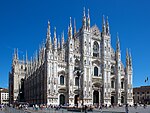Province of Milan
2015 disestablishments in ItalyFormer provinces of ItalyMetropolitan City of MilanPopulated places disestablished in 2015Province of Milan ... and 1 more
Provinces of Lombardy

The Province of Milan (Italian: Provincia di Milano) was a province in the Lombardy region, Italy. Its capital was the city of Milan. The area of the former province is highly urbanized, with more than 2,000 inhabitants/km2, the third highest population density among Italian provinces, just below the densities of the provinces of Naples and of Monza e Brianza, the latter of which was created in 2004 from the north-eastern part of the province of Milan. On January 1, 2015 the province was replaced by the Metropolitan City of Milan.
Excerpt from the Wikipedia article Province of Milan (License: CC BY-SA 3.0, Authors, Images).Province of Milan
1_33051, Milan Municipio 1
Geographical coordinates (GPS) Address Nearby Places Show on map
Geographical coordinates (GPS)
| Latitude | Longitude |
|---|---|
| N 45.464161111111 ° | E 9.1903361111111 ° |
Address
ATM Point
1_33051
20122 Milan, Municipio 1
Lombardy, Italy
Open on Google Maps










